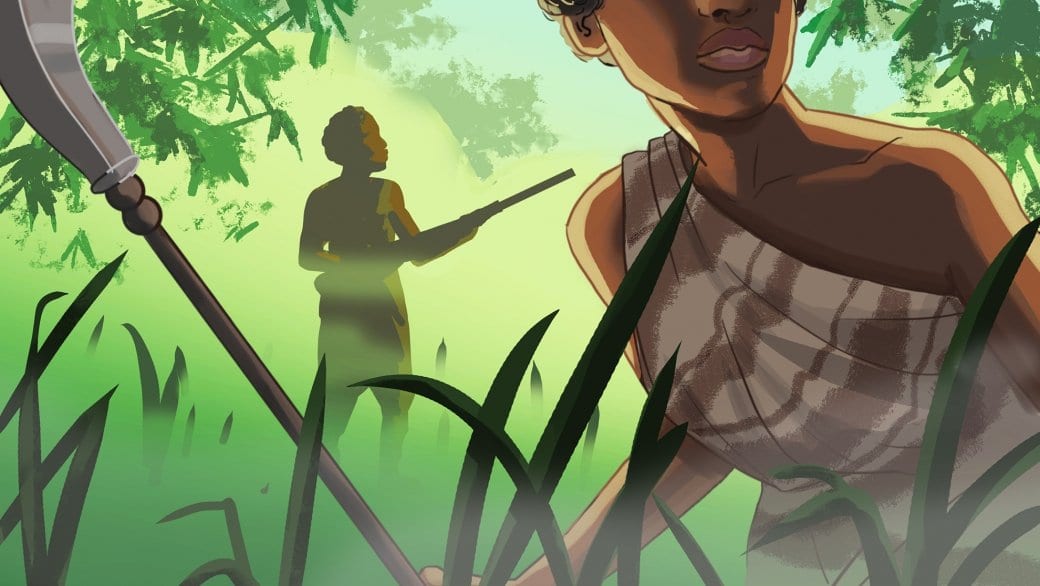The 18th-century all-female Mino warriors of the Kingdom of Dahomey are stranger-than-fiction historical figures. They were so violent and combat-ready they make Game of Thrones look like kindergartners squabbling in the sandbox.
The Mino shot muskets from the hip and preferred hand-to-hand combat. Part of their training was to crawl through piles of razor-sharp, thorny acacia branches, the bravest presented with belts made of the tree as tangible proof that pain did not affect them.
Recruits in training were also exposed to death and were included in prisoner executions. A French naval officer recalls watching an inexperienced teenage Mino lop off a prisoner’s head in three swings, remove the blood from her weapon and swallow it. When warriors walked the streets, slave girls followed them ringing bells, warning people of their approach. People avoided looking on them as they were considered death incarnate.
Dahomey, which now makes up Benin, a small sub-Saharan country that borders Nigeria, was made up of the Fon ethnic group around 1600. The militaristic, expansion-minded nation became central to the British, Dutch and Portuguese slave trade during which prisoners of war became a source of income as slaves. With the ranks of male soldiers depleted because of the constant invasions of neighbouring territories, the Mino — or N’Nonmiton, “our mothers” in the Fon language — were forged to fill the vacuum. They occupied a unique sexual and gender position in Dahomey, and were the only female soldiers in the world who routinely saw combat until recently.
Homosexuality in Dahomey was commonplace as in any other African country before Europeans invaded. The sexes were segregated early on in childhood and adolescent boys and girls ended up in intimate friendships where homosexual sex was seen as a phase, but sometimes continued for life. Blogger and African historian Anengiyefa notes that Dahomeans strongly disapprove of adult male homosexuality with secrecy shrouding same-sex relationships. “Dahomeans had a well-organised tradition of ‘best-friendships,’ and since the partners could not testify against each other, (and as it was well-known that best friendships were often based on youthful homosexual attachments), best friendships were the perfect vehicle for maintaining adulthomosexual relationships.”
In the early 20th century, anthropologist Melville J Herskovits noted that homosexuality is “found among women as well as men; by some it is claimed that it exists among women to a greater extent.”
The Mino tradition began around 1729 under King Agaja, the grandson of the nation’s foundational king. Women were used as bodyguards in the palace precincts — as men weren’t allowed entrance after dark — before the guard became a place to deposit Dahomey-style criminal women: adulterous wives, scolds and so-called “termagants” or overbearing women.
They could be sentenced to death by law, but instead of being executed they were given to the king by their chiefs, who turned them into soldiers. Eventually the corps would be made up of thousands of soldiers, voluntary and not. These women were considered to be married to their king, although he had his hands full with his own harem.
Outsiders saw the Mino as virgins or celibates. “The amazons are not supposed to marry, and, by their own statement, they have changed their sex,” wrote 19th century British naval officer Commander Frederick Forbes. “‘We are men,’ say they, ‘not women.’ All dress alike, diet alike, and male and female emulate each other: what the males do, the amazons will endeavour to surpass.” Historian Robin Law points out that Fon women weren’t seen as equals to men, but when trained as soldiers they were believed to become men, “usually at the moment they disemboweled their first enemy.”
Their numbers swelled and shrank as Dahomey’s military rule required, numbering at least 600 and up to 6,000. They ultimately met their end at the hands of French colonials in the Franco-Dahomean War of the 1890s. The conflict saw their numbers culled to around 50. Though the victors, the French recounted that the Mino fought “with extreme valor, always ahead of the other troops, well trained for combat and very disciplined.”
The few younger Mino survivors retreated into the Dahomean population as civilians , some of whom may have even lived to see the country’s independence in 1960. In Smithsonian Mag, there’s a fantastic story of a Dahomean who lived in coastal Cotonou in the 1930s and remembered tormenting an elderly woman with his friends. The children threw two stones that hit each other, making a gunshot sound. The woman seemed to go into a trance and began to perform military drills.
“With one hand she seems to pin [her imaginary victim] to the ground, and with the other, stabs him repeatedly,” the account reads. “Her cries betray her effort. She makes the gesture of cutting to the quick and stands up brandishing her trophy.
“She intones a song of victory and dances. But suddenly she stops, dazed. Her body bends, hunches. How old she seems, older than before! She walks away with a hesitant step. She is a former warrior, an adult explains. The battles ended years ago, but she continues the war in her head.”
History Boys appears on Daily Xtra on the first and third Tuesday of every month. You can also follow them on Facebook.


 Why you can trust Xtra
Why you can trust Xtra


